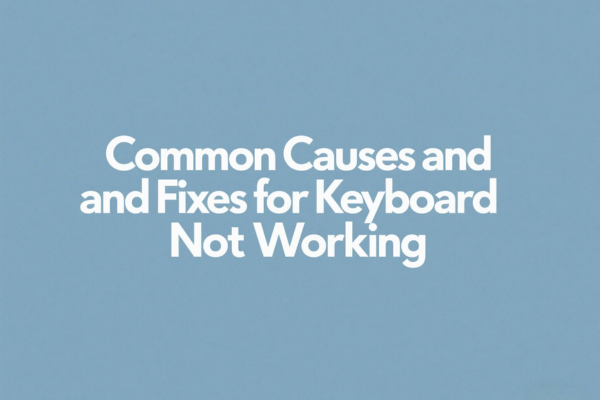Is your keyboard giving you the silent treatment? It's a frustrating situation that can throw off your work, gaming, or browsing. Whether it's a laptop keyboard or a desktop one, a non-functioning keyboard can be a real headache. In this blog, we'll explore the common reasons behind the "keyboard not working" issue and provide you with six easy steps to get it back in action. We'll also introduce you to a handy tool from pcgogo that can make the whole process even smoother.

Why Is My Keyboard Not Working?
1. Driver Woes
One of the most frequent culprits for a keyboard not working is driver problems. Outdated, corrupted, or missing drivers can prevent your keyboard from communicating properly with your computer. This is especially common when you've recently changed keyboards or updated your operating system. If you're using a Windows computer and suddenly find your keyboard not working, it could be that the existing driver is incompatible with the new setup. Driver issues can also occur for Mac users, although the system usually does a good job of keeping drivers updated automatically. But it's still possible for something to go wrong. So, if you're asking yourself, "Why is my keyboard not working?" driver problems should be high on your list of suspects. This is particularly relevant for laptop users. A laptop keyboard not working due to driver issues can be a real pain, especially when you're on the go and need to get work done.
2. Hardware Hassles
Faulty hardware can also be the reason. For instance, a problem with the motherboard can affect the keyboard's functionality. If the motherboard has a glitch, it might not send the right signals to the keyboard, causing it to work intermittently or not at all. Another hardware-related issue could be a damaged keyboard cable. If you have a wired keyboard and it's not working, check the cable for any signs of wear and tear. Wireless keyboards, on the other hand, might face issues with their battery or the wireless connection. If your laptop keyboard is not working and it's a wireless one, make sure the battery is charged and the Bluetooth connection is stable. Spilled drinks or dust buildup can also play havoc with your keyboard. If you've accidentally spilled something on your keyboard or it's been collecting dust for a while, it can cause keys to stop working. This is a common problem, especially for those who eat or drink near their computers.

3. Software Problems
Software problems can also lead to a keyboard not working. System updates sometimes cause issues with peripheral devices like keyboards. An update might change some settings that affect the keyboard's operation, or it could even introduce a bug. Additionally, power-saving features on your laptop can sometimes be too aggressive and cause the keyboard to stop working. If your laptop goes into power-saving mode too quickly, it might disconnect the keyboard to save battery. And let's not forget about accessibility features. If you've accidentally enabled features like filter keys or sticky keys, it can make your keyboard behave erratically.
5 Steps to Fix Your Keyboard Not Working
1. Update Your Keyboard Drivers
Updating your keyboard drivers is often the first step to solving the "keyboard not working" problem. At pcgogo, we recommend using our Driver Sentry tool. It's a great way to ensure your drivers are up-to-date. With Driver Sentry, you don't have to worry about manually searching for the right drivers or accidentally downloading the wrong ones. Just click the download button to get the latest version. After installation, open the software and click "Scan". Driver Sentry will automatically detect any drivers that need to be updated, including your keyboard driver. Once the scan is complete, find the keyboard driver in the list and click "Upgrade". After the update, restart your computer to make sure the new driver takes effect. This is an important step, especially if you're dealing with a laptop keyboard not working due to driver issues.
2. Restart Your Computer
A simple restart can work wonders. Before you restart, make sure to save any important work to avoid data loss. Then, open the "Start" menu (or the Apple menu if you're using a Mac), select the "Power" icon, and click "Restart". When your computer boots back up, check if your keyboard is working. Many times, a restart can fix temporary software glitches or memory issues that are causing the keyboard problem. It's a quick and easy solution that you should always try first, whether you're dealing with a desktop or a laptop keyboard not working.
3. Enable the On-Screen Keyboard
If your physical keyboard is not working, the on-screen keyboard can be a useful temporary solution. On Windows, press the Windows key + I to open "Settings", then click "Ease of Access" and select "Keyboard". Enable the "On-Screen Keyboard" option. You can also turn it on or off by pressing the Windows logo key + Ctrl + O. On a Mac, you can find the on-screen keyboard settings in the Apple menu under "System Settings" and then "Keyboard". This allows you to type using your mouse until you fix the problem with your physical keyboard. However, remember that it's just a temporary fix, and you should aim to resolve the issue with your actual keyboard as soon as possible.

4. Disable Filter Keys and Sticky Keys
Accidentally enabled accessibility features like filter keys and sticky keys can mess with your keyboard's normal operation. To disable them on Windows, press the Windows key + I to open "Settings", click "Ease of Access", and then select "Keyboard". In the "Sticky Keys" and "Filter Keys" sections, make sure the options are turned off. On a Mac, you can find similar settings in the "Keyboard" section of "System Settings". After disabling these features, check if your keyboard is working properly. This is a quick fix that can solve many keyboard-related issues.
5. Clean Your Keyboard
Dirt and debris can accumulate on your keyboard over time, causing keys to stick or stop working. Before cleaning, turn off your computer to avoid any damage. Employ compressed air to blow off the dust and debris situated between the keys. Then, gently wipe the keyboard surface with a soft microfiber cloth to remove any stains. For hard-to-reach places, use a cotton swab or a small brush. But be careful not to use too much moisture, as water can damage the keyboard's internal components. Regular cleaning can prevent many keyboard problems and keep your keyboard in good working condition.
Conclusion
A keyboard not working can be a real annoyance, but with the right steps, you can usually get it working again. Whether it's a laptop keyboard not working or a desktop one, the solutions we've discussed in this blog should help you resolve the issue. And don't forget about Driver Sentry. It's a great tool to keep your drivers updated and prevent future keyboard problems. If none of these methods work, it might be time to seek help from a professional technician. But in most cases, a little troubleshooting and the right tools can get your keyboard back to its normal, reliable self. So, the next time you find yourself asking, "Why is my keyboard not working?", you'll know exactly what to do.